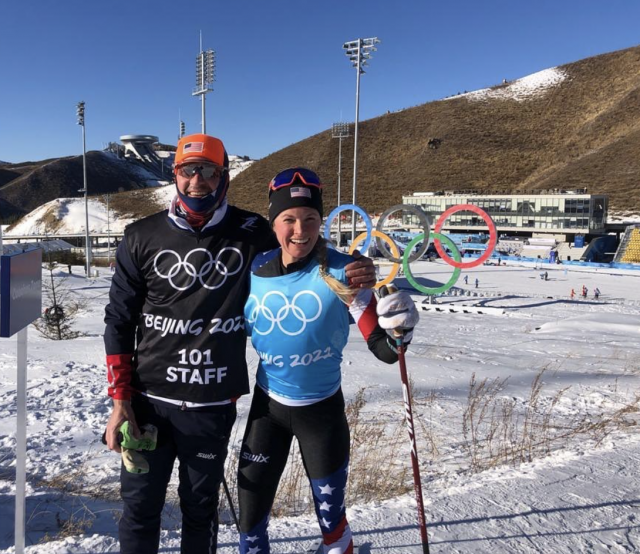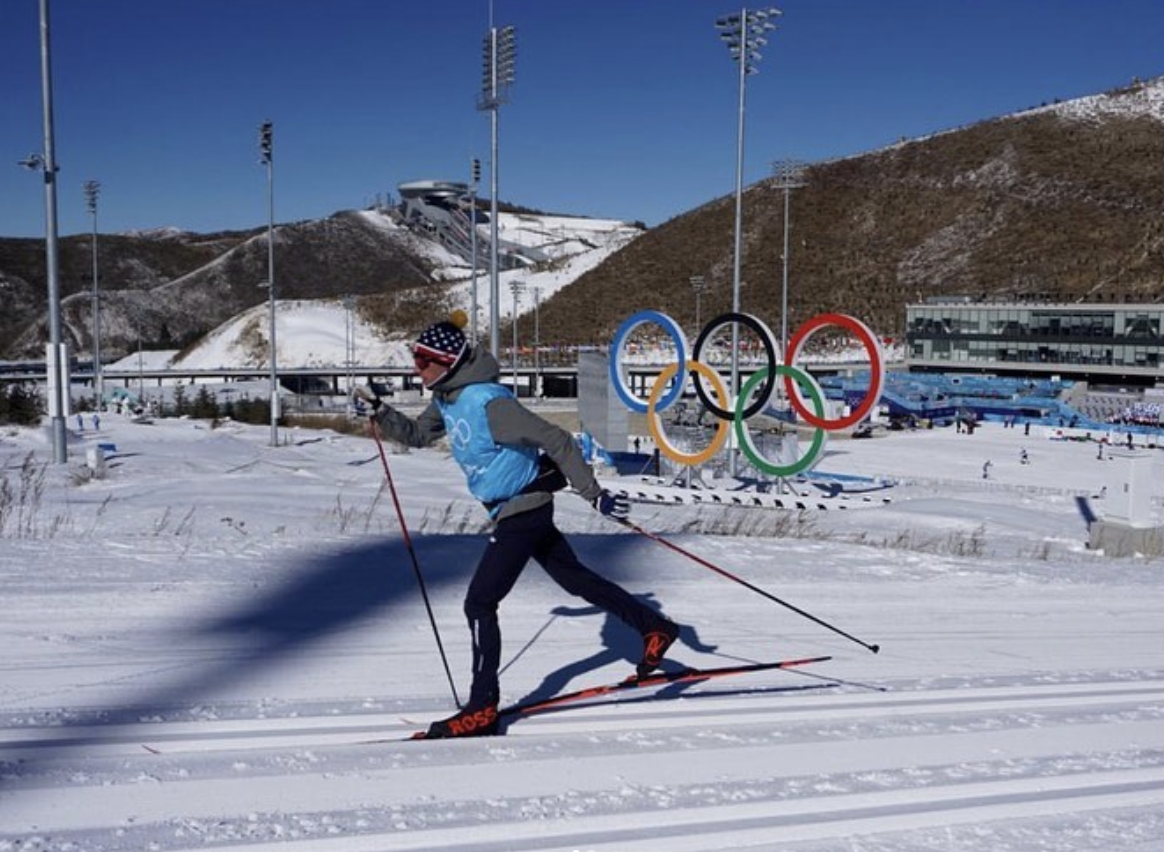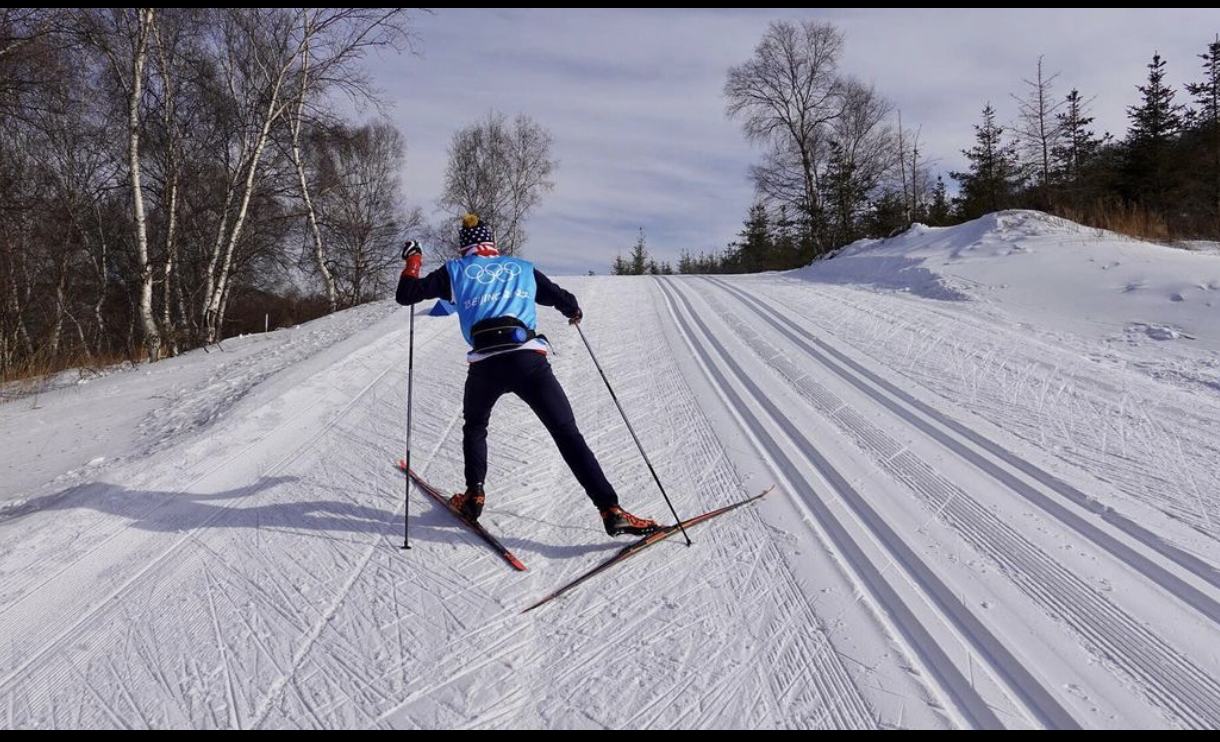
The ski trails at the Zhangjiakou Olympic venue – completed during the pandemic – will be seen with fresh eyes for most athletes and service staff as they arrive ahead of the 2022 Games. For service teams that often prepare years in advance of an Olympics, the uncertainty surrounding Zhangjiakou, from its weather to its snow, is a new phenomena. What is certain is that climatically, there is the potential for some very interesting conditions.
Clare Egan of the US Biathlon Team said, “we know it’s going to be really cold and really windy, and pretty bad conditions generally for biathlon, but we’re gonna make the best of it, I guess.”
Ole Einar Bjørndalen, Head Coach of the Chinese Biathlon Team who spent all of last winter with the team in China, told NRK that it was a struggle to manage training during weeks of thirty below temperatures. Then, in March and April, three sandstorms blew through, filling the sky all the way to Beijing with a thick ocre haze of desert particulate.
Meteorologically, Zhangjiakou is not situated in an enviable position. The ski trails are nestled in an open valley within a high arid plateau. This mountain range is the first barrier in the path of Siberian winds that blow out of the Lake Baikal Basin—one of the coldest areas on earth—and across the Mongolian Steppe and the desert of Inner Mongolia. If the winds are strong enough, they pick up sand and grit and deposit their cargo along the way.
A sandstorm, should one occur, would be a dramatic twist at the Olympics. Anders Högberg, coach of the Swedish men’s national team, has experienced sand snow while racing in China. “I have, in Inner Mongolia, skied when sand colored the snow yellow,” Högberg said in an interview with the Swedish publication Aftonbladet. “…If there is a sandstorm in the middle of a competition, it will probably be canceled or moved forward, but I can imagine that [there] will still be a mixture of sand in the snow.”
Former Danish skier Troels Hein Bünger raced in China during his career and described the snow as being so dry “that you cannot make an honest snowball. If sand is added, the quality of the substrate will only get worse.”
Bünger said the effect was the same as rubbing sandpaper across the skis. He believed that the Games have the potential to be “the slowest Olympics in recent times,” comparable only to races in the wooden ski era.
While dirty snow will certainly be a concern among service crews, plans are in place to tackle the problem, built on experience from previous sandy championships such as PyeongChang 2018 and Oberstdorf 2021.

US Ski Team Coach Jason Cork said in an email that the team is not “especially worried about the ‘sand’ at the venue. We’ve gotten reports that it’s similar to PyeongChang – snow which is dirty with fine particulate, rather than large grains. We’ll deal with it the same way we deal with dirty snow all over the world: Good cleaning of the skis after they’ve been used, and a lot of testing to identify waxes and structures which repel the contamination as much as possible.”
Staff on the Finnish ski team went a step further during their reconnaissance trip in late December. The Finns took snow samples to be melted and carried home for analysis. “I don’t know how much it will ultimately benefit, but everything possible needs to be done,” Logistics Manager Matti Haavisto said to Yle. “We want to know what particles are in the snow, what kind of contaminants. The snow is dirtier here than in Europe.”
Tobias Dahl Fenre, head of ski service for the Norwegian Biathlon team, suggested to NRK that the procedure at the Beijing Olympics for his team would be much the same as in PyeongChang: Daily grinding of skis.
For nations without a grinder on site, this could pose a problem.
One way to address the problem is to send over a vast quantity of skis. This is the method embraced by the Norwegian alpine team, according to NRK. Due to the labor of grinding and tuning alpine skis, they have opted to send as many as 70 pairs per athlete, a number Norwegian skier Aleksander Aamodt Kilde calls “completely crazy.”
While Zhangjiakou may be known for biting cold snaps, brisk sand laden winds, and almost no natural snowfall, that is not always the rule. Conditions may also be ideal, with sunny warm days and cold nights. In an interview with a Finnish news outlet, Teemu Lemmettylä, a biomechanist who visited the site in December on behalf of the Finnish Ski Association, described perfect conditions: overnight temperatures fell to 14 Fahrenheit and warmed in the day to around freezing.
In any case, to the service teams’ advantage is the likelihood the snow will be entirely artificial. Zhangjiakou receives only a few centimeters of natural snow per winter, meaning the trails will have a uniformity not always seen at other sites where natural and artificial snow meld. The consistency of the snow has allowed Norway to look for solutions at home.

This poses an odd conundrum for wax teams, as the ‘unthinkable scenario is not necessarily a sandstorm, but natural snowfall,’ as Norwegian Cross County Director Espen Bjervig put it to Aftonbladet.
Bjervig also outlined his most dire service concern at the Olympics: “What we fear most is that there is some natural snow and that it can blow sand into the track. We have no experience [with] that. It’s new.”
Yet all is not easy with snow making at Zhangjiakou either. Reuters interviewed Jacques Fournier, a Swiss snowmaker working at the cross country venue. “The main challenge is to make the snow as wet as possible in the drier local conditions to keep it on the track,” Fournier said, along with controlling “the evaporation during the snow production and [making] sure to store it in the track as compactly as possible.”
Snow that is made too dry will either disappear, or fail to bond together, and allow the winds to blow it away. The solution is wet, sticky snow that is heavily compacted by grooming to withstand the winds.
As a result, snowmaking in the local conditions requires more water than usual. The ground must be soaked first to freeze the ground, and much water is lost to both evaporation and winds.
The reliance on snowmaking at the 2022 Olympics, which is essentially being held in a cold desert, has been criticized from an environmental standpoint. Staging the Games will reportedly require estimates of between 49 and 528 million gallons of water over the various venues. If the later estimate is accurate, it would be enough water to blow snow on a twenty foot wide trail for more than 4,000 kilometers — a use of water resources that has been questioned considering that the region relies in part on water pipelines and desalination plants to supply its needs.
For athletes, the altitude of Zhangjiakou has been a priority for preparations over the last two years. The trails are at an elevation between 5,419 feet to 5,643 feet. The venue is strikingly similar in design and setting to Soldier Hollow in Utah, and designed by the same person: John Aalberg. In terms of elevation, Soldier Hollow trails average 100 feet higher than Zhangjiakou.
In an email to FasterSkier, John Aalberg noted the resemblance of the two venues: “Of all the [Olympic] courses in the last 24 years (since I have been involved in Games courses), the 2022 courses are most similar to the Soldier Hollow courses. Perhaps this is because I designed/co-designed both of them, but the terrain, elevation, and climate are also quite similar. Both courses are very spectator friendly, have ‘skiable’ uphills (good for diagonal striding), etc.”
If anything, Aalberg improved upon the course design of Soldier Hollow, writing, “I was able to design an even better finish for these 2022 courses, with both a long uphill (similar to Hermod’s Hill), an exciting downhill right above the stadium, and a small uphill coming into the stadium (the high speed coming into the Soldier Hollow stadium is not optimal).”
Aalberg also listed the features that he thought made the upcoming Olympic venue unique: “a ‘velodrome’ downhill corner coming back down towards the stadium leading up to the final 500 meters,” as well as wide and “fair” uphills, a “quite easy sprint course” that is the same for both men and women, and the “tens of thousands of trees planted adjacent to the courses.”

For ski service crews, mundane issues may be the most pressing. In an interview with ABC News in Norway, Fenre, the head of Norway’s biathlon team, said “snow conditions are definitely what worries me the least. I am most concerned about logistics and that we get wax and equipment through customs. If we are in China at the right time with the right equipment, I am very happy.”
To that end, Finland sent a grinder and wax supplies to China in October, and teams have acknowledged that a resupply during the Games may not be possible.
In December many teams, including US Biathlon, sent service staff to investigate the venue in China for the first time. Prior to that, the only information available to athletes was a video taken by the team that installed the biathlon targets last winter. The snowmobile video “circulated quite a bit,” said Clare Egan. “Between that and the course map and profile map you can get an idea.”
In Finland, preparations went further. The Vuokatti Ski Team built a virtual race track with expertise from local universities. Katri Lylynperä skied the virtual track so many times she told Yle that she “already knows the track…”
Information on the course has arrived in the US Biathlon camp after the team’s wax techs traveled to China the week after Christmas and “took a [ton] of pictures and video,” Egan said.
That course intel was shared with the US Ski Team, according to Jason Cork, who wrote, “We’ve spent a lot of time looking at the course homologation maps to help identify training courses that come close to the climbs we’ll see there.”
Weather conditions are also on the mind of US Ski Team coaches. “Of course, we’re watching the weather reports and forecasts a lot,” wrote Cork. “We’re going into the venue with about as much information as every other team (barring the Chinese), so I don’t think we’re at any disadvantage.”
Federico Fontana, the head of race service for the US Biathlon Team described the biathlon trail in an email to FasterSkier from the Olympic venue. “The course is technical, and challenging, we don’t really have long and extremely steep climbs, but a lot of transition and false flat parts.” Fontana added, “In my opinion a very crucial part of the course is the part behind the range before the fast downhill [heading to] the final 200m or range entrance.” It is there, Fontana thought, that many races will be decided.

Wind will be a key factor in biathlon, “not just for shooting but for skiing as well,” wrote Fontana, who described a consistent wind blowing through the valley. In the first half of the course biathletes will enjoy a tailwind, but when they turn back to the stadium and range there will be a strong headwind.
“In December when [we were] here testing skis we “had every day [a] strong wind,” wrote Fontana, adding, “and it‘s a very cold wind! Skiing alone back to the stadium can be a problem. It’s a very challenging course, not for everyone.”
While many teams placed a premium on an early reconnaissance of the Zhangjiakou, Stein Olav Snesrud, head of Norway’s cross country service team told ABC News in Norway that he doubted the early tests would be very relevant to the conditions the athletes will experience in February. “What we have learned is that a lot happens… throughout January,” he said. “It has been shown… that the conditions you test long before a championship are not necessarily the ones that apply when the Olympics are held. There was a big difference [in conditions] before the Olympics in [PyeongChang]… and then it was completely different [at] the Olympics.”
Whatever the conditions occur at the Zhangjiakou venue over the course of the Olympic Games, surprises are likely to await.
Pasha Kahn
Pasha Kahn writes and coaches in Duluth, Minnesota.



